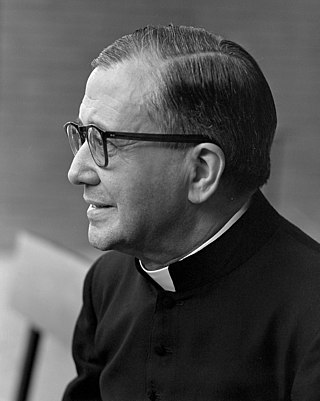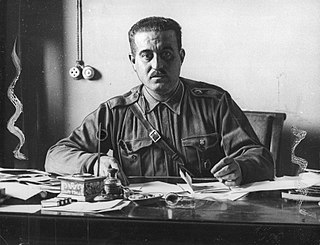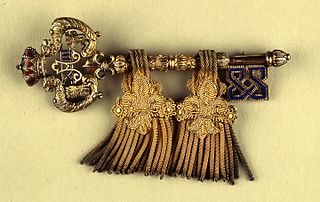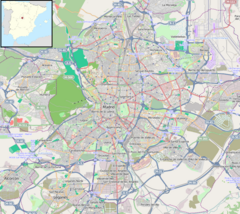
Saint Josemaría Escrivá de Balaguer y Albás was a Spanish Catholic priest who founded Opus Dei, an organization of laypeople and priests dedicated to the principle of everyday holiness. He was canonized in 2002 by Pope John Paul II, who declared Josemaría should be "counted among the great witnesses of Christianity."

The Madrid Metro is a rapid transit system serving the city of Madrid, capital of Spain. The system is the 14th longest rapid transit system in the world, with a total length of 293 km (182 mi). Its growth between 1995 and 2007 put it among the fastest-growing networks in the world at the time. However, the European debt crisis greatly slowed expansion plans, with many projects being postponed and canceled. Unlike normal Spanish road and rail traffic, which drive on the right, Madrid Metro trains use left-hand running on all lines because traffic in Madrid drove on the left until 1924, five years after the system started operating.

Manuel Leguineche Bollar, better known as Manu Leguineche, was a Spanish correspondent, journalist and writer. He was born in Arratzu, Biscay. He was one of the contributors of Doblón magazine from 1974 to 1976. He founded the Spanish news agencies Colpisa and Fax Press. He divorced from Rosa María Mateo.

The University of Navarra is a private research university located on the southeast border of Pamplona, Spain. It was founded in 1952 by Josemaría Escrivá de Balaguer, the founder of Opus Dei, as a corporate work of the apostolate of Opus Dei. The University of Navarra is among the best private universities in Spain. The University of Navarra is third in the "European Teaching Rankings of 2019" by Times Higher Education's International Rankings.

José María de la Blanca Finat y Escrivá de Romaní was a Spanish politician and government official who held several important posts in Francoist Spain. After the Civil War he was named Director General of Security and from 1952 to 1965 he was the Mayor of Madrid.

José Antonio Nieves Conde was a Spanish film maker, journalist, and screenplay writer, the director of feature films such as Surcos [Furrows] (1951), Angustia [Anguish] (1947), and Balarrasa [Reckless] (1951).

Line 11 of the Madrid Metro is a rapid transit line in Madrid, Spain. The line originally opened between Plaza Elíptica and Pan Bendito on 16 November 1998.
Manuel Summers Rivero was a Spanish film director, screenwriter and actor.

Manuel Fal Conde, 1st Duke of Quintillo was a Spanish Catholic activist and a Carlist politician. He is recognized as a leading figure in the history of Carlism, serving as its political leader for over 20 years (1934–1955) and heading the movement during one of its most turbulent periods. Initially he led the belligerent faction pressing anti-Republican insurgency; during the Spanish Civil War he joined the Nationalists; later on he championed the anti-Francoist strategy.

The Gentilhombres de cámara con ejercicio was a palatine class of honorary royal servants of the Royal Household and Heritage of the Crown of Spain, who acceded to that class as an honor awarded by the Monarch. The members of this class neither had specific functions inside the ceremonial scheme of the Court, nor exercised active service with a few exceptions, being their appointment a sign of the royal appreciation.

El Golf is an underground metro station on the Line 1 of the Santiago Metro, in Santiago, Chile. It is located in El Golf neighborhood, close to the building that serves as the seat of local government for Las Condes. The station was opened on 22 August 1980 as part of the extension of the line from Salvador to Escuela Militar.
Don Quijote cabalga de nuevo is a 1973 Spanish-Mexican comedy film directed by Roberto Gavaldón, loosely based on Miguel de Cervantes's novel Don Quixote and starring Cantinflas as Sancho Panza, Fernando Fernán Gómez as Don Quixote, and María Fernanda D'Ocón as Dulcinea.

Manuel Becerra is a station on Line 2 and Line 6 of the Madrid Metro, located in the Plaza de Manuel Becerra, Salamanca district in fare Zone A. The station is named after the plaza, which was named for 19th-century politician Manuel Becerra y Bermúdez.

Diego de León is a station on Line 4, Line 5, and Line 6 of the Madrid Metro, located at the intersections of Francisco Silvela, Diego de León, and Conde de Peñalver streets in the Salamanca district of Madrid. It is in Zone A.

Sainz de Baranda is a station on Line 6 and Line 9 of the Madrid Metro, located at the intersection of Doctor Esquerdo and Alcalde Sainz de Baranda streets in the Retiro district in Madrid, Spain. It is located in fare Zone A. The station is named after the street, which in turn is named after the first mayor of Madrid, Pedro Sainz de Baranda.

Alonso Martínez is a station on Line 4, Line 5 and Line 10 of the Madrid Metro. It is located in Zone A.

Casa de Campo is a station on Line 5 and Line 10 of the Madrid Metro that is situated near the Paseo de la Puerta de Batán in the Moncloa-Aravaca district and the Casa de Campo barrio. It is located in fare Zone A.

Manuel de Falla is a station on Line 10 of the Madrid Metro, on the calle de Manuel de Falla, named for the composer and pianist Manuel de Falla (1876–1946). It is located in fare Zone B1.

Count of Mayalde is a noble title created in 1596 by King Philip II of Spain for Juan de Borja y Castro son of Saint Francis Borgia, 1st Marquis of Lombay.

Guadalupe Ortiz de Landázuri Fernández de Heredia was a Spanish Catholic professor and a member of Opus Dei. She was one of the first women to join Opus Dei, after meeting the founder Josemaría Escrivá in 1944. She helped start Opus Dei in Mexico and also collaborated directly with Escrivá in Rome. A serious heart condition eventually claimed her life in 1975.



















